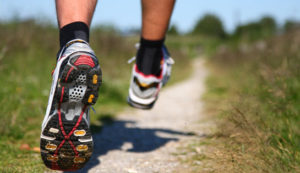
-
Never carry more than 10% of your body weight
-
Always wear a backpack over both shoulders
-
Pack heavy items closest to your spine
We often associate back pain with growing older, but these days many children and young people are experiencing back pain discomfort too. Often, the cause of the back pain for children is a result of carrying excessive loads to and from school in ill-fitting backpacks.
What happens when you wear a heavy backpack?
The spine is made of 33 bones called vertebrae and between the vertebrae are discs that act as natural shock absorbers. When a heavy backpack, with too much weight is placed on the shoulders of a child it can pull them backwards. To compensate this imbalance, the child may bend forward at the hips or arch the back, which can cause the spine to compress the discs unnaturally.
More
Reduce the Risk of Running Injuries

Now that the warmer weather is here, it’s very appealing to get outside and enjoy the fresh air – and for many people that enjoyment includes running. Running is really a fabulous form of cardiovascular exercise, but unfortunately it can also lend itself to some very common injuries. Here are a few tips to keep you running healthy:
More
It’s great to see more kids than ever involved in athletics and organized sports. But research shows us that sport is the main cause of injury in adolescents.
Active growing children will go through normal aches and growing pains. The pain usually only lasts a few days, they are in mild discomfort, and it doesn’t really inhibit their activity. Often rest or a few days off sport will help these cases.
But if children are experiencing the following symptoms…
Visit your physio or MD for diagnosis and treatment.
Pain that lasts over 4 days
Increasing sharp pains
Pain that gets worse with activity
Pain that stops participation
Limping or favouring the injury or body part
Not sleeping well
Redness or swelling around the area – or talk of numbness
Most common injuries in children are: ankle sprains, wrist sprains or fractures, sore backs from poor posture, scoliosis and knee pain.
Understanding kid’s physical abilities during different stages of their lives is the best way to help support them to stay active and safely develop their athletic abilities. It can also help parent’s understand and detect if their child may have physical restrictions or an injury that needs to be treated by a physiotherapist.
TIP TO REMEMBER: Early treatment results in less time away from sport, and generally less treatment.
More
SAFE GARDENING FOR YOUR BODY
Gardening is a great outdoor activity that can be both meditative as well as physically active. Unfortunately, many avoid gardening since it can aggravate the back, hips and knees. Gardening does not have to be an impossible task, simply follow these tips listed, and gardening can be an enjoyable hobby once again.
GETTING STARTED
Preparation is an important part to keeping your body happy and healthy. Make sure to do the following before doing any gardening.
-
Have the Proper Tools Ready:
Do your body a favor and get tools with longer, adjustable handles. This will allow your body to maintain a more neutral position.
For heavy lifting, use a wheelbarrow so your muscles are able to do less work.
For kneeling, get knee pads to lessen the impact on the knee joint.
PLAN YOUR GARDEN
Create a more manageable garden: think high, think small. Consider a standing garden that is raised high enough so you don’t have to bend at all. Also, having a smaller garden means less weeding and maintenance which can save the wear and tear of the joints.
More
PLAY BETTER GOLF
THROUGH IMPROVED PHYSICAL CONDITIONING
The golf swing is a complex coordinated movement of muscles and joints in our body.
The spine itself is required to rotate to near maximal ranges of motion in two directions as we complete our backswing, downswing and follow through. The modern swing has seen increased emphasis on power (and distance) generated from our torso, creating larger demand on our core, obliques, middle and lower back. As it pertains to golf – spine and abdominal fitness not only improves performance and controlled motion, but decreases the risk of injury as golfers execute the repetitively hazardous action of the swing. A warm-up is also very important as we prepare our muscular engines for several hours of physical activity.
Physiotherapists are frequently involved with numerous clients experiencing stiffness, weakness, and/or pain in their spines, shoulders, elbows, knees and ankles. There are many exercises, manual techniques, and modalities that our therapists use to improve the physical health of these areas of concern. Strength and mobility in these areas is extremely important for a healthy and happy golf season.
More


